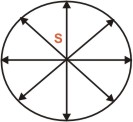The nature of waves is an important theory you’d need to grasp (or minimally understand) before we go in depth into talking about whales and their lives underwater!
Waves are everywhere. They are constantly occurring around us and it happens regardless of whether we manage to recognize them as waves or not. When we think of waves, the first thing you’ll think of is the motion of waves, or wave motion. Look at the video below!
Be it the vibrations in ropes, or waves in a ripple tank, we can have an idea on what waves are like – in this case, it’s a disturbance which travels and propagates through a medium (the rope and the water respectively). And a few examples of the basic waves that we encounter in our everyday lives would be sound waves, visible light waves, microwaves, water waves and also radio waves.
A wave is made up of periodic motion (motion repeated at regular intervals), and can be defined as a disturbance that travels from one location to another and propagates through a medium. Waves can transfer energy, momentum or even information from one location to another, but it will never transfer matter. The source being a vibration or oscillation.
Look at the video below!
We can observe from the video that the rope waves travel, while the rope itself only moves up and down. This is because the rope is the medium through which the waves move or propagate. In terms of energy, the kinetic energy (KE) from the up-and-down movement is transferred in the form of a rope wave from one end to another, but the rope itself is not actually moving.
Waves transfer energy (the up-and-down movement) without transferring matter (rope)
Waves can be classed into groups via different means either by how the waves orientate (transverse or longitudinal) or by the medium it uses to ‘transfer’ itself from one location to the next.
Wavefront – A locus of points/a line in the path of wave motion having the same phase. For example, all the peaks are in the same phase
An example of a wavefront is a cylindrical wavefront. As seen in the picture above, when multiple waves are produced from the source S, the peaks or troughs of the waves are in the same phase, thus the imaginary cylindrical line can be drawn over the points in the same phase. That is a wave front.
This is how you would picture a wave in physics:
 Crest: highest point of its oscillation
Crest: highest point of its oscillation
Trough: lowest point of its oscillation
Wavelength: distance between two crests/troughs
Period: time taken to complete one crest and one trough
Amplitude: distance from the point of the origin to the crest of the trough
This is very similar to the sine graph you can plot on your GC! And this is an example of a transverse wave.
Transverse Waves
A transverse wave is a moving wave that has oscillations of the medium that occur perpendicular or at a right angle to the direction at which the energy is transferred. This means that if the direction of energy is moving towards the positive x-direction, the movement of the oscillations will be up and down parallel to the y-axis and perpendicular to the x-axis. Due to the oscillations moving up and down at right-angles to how the energy is being transferred, it causes transverse waves to consist of two parts, namely the crest and the trough.
One example of a transverse wave would be a light wave.
Longitudinal Waves
A longitudinal wave is a wave that has vibrations of the medium that occur parallel to the direction at which the energy is being transferred, meaning that the movement of the medium is either in the same or opposing direction of the motion of the wave. So if the direction of energy is moving towards the positive x-direction, the vibrations will occur along the x-axis, either to the positive or negative end, parallel to the motion of the wave. Due to the vibrations occurring in the same direction as the motion of the wave, longitudinal waves do not have amplitudes. In a mechanical longitudinal wave, it is also called compression wave as compressions and rarefactions, which are the opposite of compressions, are produced and they can be used to find the wave’s period and wavelength. Compression occurs when the particles are forced or pushed together while rarefaction is when particles are given additional space to expand. The wavelength of a longitudinal wave is the distance between two compressions and the period is the time taken for 1 compression and 1 rarefaction to occur. One example of a longitudinal wave is a sound wave.

A longitudinal wave can be plotted into a pressure/(time/distance) graph in order to find the wavelength and period as shown below. In compressions, as the particles are forced together thus there is a drop in volume while in rarefactions, the particles are given more space in order to expand, causing an increase in volume. Therefore this causes the pressure at compressions to be high and at rarefactions to be low.
Sound waves, waves in a slinky are examples of a longitudinal wave!
Hope you learnt something about waves! Till next time 🙂
-Science Geek


